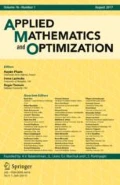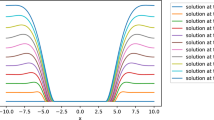Abstract
We analyze a linear 3D/3D fluid–structure interaction problem between a thin layer of a viscous fluid and a thin elastic plate-like structure with the aim of deriving a simplified reduced model. Based on suitable energy dissipation inequalities quantified in terms of two small parameters, thickness of the fluid layer and thickness of the elastic structure, we identify the right relation between the system coefficients and small parameters which eventually provide a reduced model on the vanishing limit. The reduced model is a linear sixth-order thin-film equation describing the out-of-plane displacement of the structure, which is justified in terms of weak convergence results relating its solution to the solutions of the original fluid–structure interaction problem. Furthermore, approximate solutions to the fluid-structure interaction problem are reconstructed from the reduced model and quantitative error estimates are obtained, which provide even strong convergence results.

Similar content being viewed by others
References
Avalos, G., Triggiani, R.: The coupled PDE system arising in fluid/structure interaction. I. Explicit semigroup generator and its spectral properties. Fluids and waves, 15–54, Contemp. Math., 440, Amer. Math. Soc., Providence, RI (2007)
Avalos, G., Triggiani, R.: Semigroup well-posedness in the energy space of a parabolic-hyperbolic coupled Stokes-Lamé PDE system of fluid-structure interaction. Discr. Contin. Dyn. Sys. Ser. S 2, 417–447 (2009)
Avalos, G., Lasiecka, I., Triggiani, R.: Higher regularity of a coupled parabolic-hyperbolic fluid-structure interactive system. Georgian Math. J. 15, 403–437 (2000)
Bayada, G., Chambat, M.: The transition between the Stokes equations and the Reynolds equation: a mathematical proof. Appl. Math. Optim. 14(1), 73–93 (1986)
Becker, J., Grün, G.: The transition between the Stokes equations and the Reynolds equation: a mathematical proof. J. Phys.: Condens. Matter 17, 291–307 (2005)
Bertozzi, A.: The mathematics of moving contact lines in thin liquid films. Notices Am. Math. Soc. 45, 689–697 (1998)
Bodnár, T., Galdi, G.P., Nečasova, Š.: Fluid-Structure Interaction in Biomedical Applications. Springer, Birkhouser (2014)
Bolotin, V.V.: Nonconservative Problems of the Theory of Elastic stability. Pergamon Press, London (1963)
Bukač, M., Čanić, S., Muha, B., Glowinski, R.: An operator splitting approach to the solution of fluid-structure interaction problems in hemodynamics, science engineering. In: Glowinski, R., Osher, S., Yin, W. (eds.) Splitting Methods in Communication and Imaging Science and Engineering. Springer, New York (2016)
Bukal, M., Muha, B.: A review on rigorous derivation of reduced models for fluid-structure interaction systems. To appear in Waves in Flows, Eds. T. Bodnár, G. P. Galdi, and Š. Nečasová, Birkhäuser, Cham (2020)
Bukal, M., Muha, B.: Justification of a nonlinear sixth-order thin-film equation as the reduced model for a fluid--structure interaction problem. In preparation (2020)
Bunger, A.P., Detournay, E.: Asymptotic solution for a penny-shaped near-surface hydraulic fracture. Engin. Fract. Mech. 72, 2468–2486 (2005)
Čanić, S., Mikelić, A.: Effective equations modeling the flow of a viscous incompressible fluid through a long elastic tube arising in the study of blood flow through small arteries. SIAM J. Appl. Dyn. Syst. 2(3), 431–463 (2003)
Chambolle, A., Desjardins, B., Esteban, M.J., Grandmont, C.: Existence of weak solutions for the unsteady interaction of a viscous fluid with an elastic plate. J. Math. Fluid Mech. 7(3), 368–404 (2005)
Chueshov, I.: Dynamics of a nonlinear elastic plate interacting with a linearized compressible viscous fluid. Nonlinear Anal. 95, 650–665 (2014)
Chueshov, I., Dowell, E.H., Lasiecka, I., Webster, J.T.: Mathematical aeroelasticity: a survey. J. MESA 7, 5–29 (2016)
Ciarlet, P.G.: Mathematical Elasticity: Three-Dimensional Elasticity. North-Holland Publishing Co, Amsterdam (1988)
Ciarlet, P.G.: Mathematical Elasticity, Theory of Plates. North-Holland Publishing Co, Amsterdam (1997)
Cioranescu, D., Damlamian, A., Griso, G.: The Periodic Unfolding Method: Theory and Applications to Partial Differential Problems, Series in Contemporary Mathematics 3. Springer, New York (2018)
Coutand, D., Shkoller, S.: The interaction between quasilinear elastodynamics and the Navier-Stokes equations. Arch. Ration. Mech. Anal. 179(3), 303–352 (2006)
Ćurković, A., Marušić-Paloka, E.: Asymptotic analysis of a thin fluid layer-elastic plate interaction problem. Appl. Anal. 98, 2118–2143 (2019)
Das, S.B., Joughin, I., Behn, M., Howat, I., King, M.A., Lizarralde, D., Bhatia, M.P.: Fracture propagation to the base of the Greenland ice sheet during supraglacial lake drainage. Science 320, 778–781 (2008)
Daw, R., Finkelstein, J.: Lab on a chip. Nat. Insight 442, 367–418 (2006)
Destuynder, P.: Asymptotic behavior of structures made of plates. ESAIM Math. Model. Numer. Anal. 15, 331–369 (1981)
Dowell, E.H.: A Modern Course in Aeroelasticity. Volume 217 of the Solid Mechanics and Its Applications Book Series. Springer, New York (2015)
Du, Q., Gunzburger, M.D., Hou, L.S., Lee, J.: Analysis of a linear fluid-structure interaction problem. Discr. Contin. Dyn. Syst. 9, 633–650 (2003)
Duvnjak, A., Marušić-Paloka, E.: Derivation of the Reynolds equation for lubrication of a rotating shaft. Arch. Math. 36, 239–253 (2000)
Galdi, G.P.: An introduction to the Navier–Stokes initial-boundary Value Problem. In: Galdi, G.P., Heywood, J.G., Rannacher, R. (eds.) Fundamental Directions in Mathematical Fluid Mechanics. Advances in Mathematical Fluid Mechanics. Birkhäuser, Basel (2000)
Galdi, G.P.: An Introduction to the Mathematical Theory of the Navier-Stokes Equations: Steady-State Problems. Springer, New York (2011)
Gilbarg, D., Trudinger, N.S.: Elliptic Partial Differential Equations of Second Order, p. 401. Springer, Berlin, New York (1977)
Griso, G.: Asymptotic behavior of structures made of plates. Anal. Appl. 3, 325–356 (2005)
Heil, M., Hazel, A.L., Smith, J.A.: The mechanics of airway closure. Respir. Physiol. Neurobiol. 163, 214–221 (2008)
Hewit, I.J., Balmforth, N.J., de Bruyn, J.R.: Elastic-plated gravity currents. Eur. J. Appl. Math. 26, 1–31 (2015)
Hosoi, A.E., Mahadevan, L.: Peeling, healing and bursting in a lubricated elastic sheet. Phys. Rev. Lett. 93, 137802 (2004)
Huang, R., Suo, Z.: Wrinkling of a compressed elastic film on a viscous layer. J. Appl. Phys. 91, 1135–1142 (2002)
Kaltenbacher, B., Kukavica, I., Lasiecka, I., Triggiani, R., Tuffaha, A., Webster, J.T.: Mathematical Theory of Evolutionary Fluid-Flow Structure Interactions. Birkhuser, Berlin (2018)
King, J.R.: The isolation oxidation of silicon the reaction-controlled case. SIAM J. Appl. Math. 49, 1064–1080 (1989)
Lauga, E., Brenner, M.P., Stone, H.A.: Microfluidics: the no-slip boundary condition. In: Foss, J., Tropea, C., Yarin, A. (eds.) Handbook of Experimental Fluid Dynamics. Springer, New-York (2005)
Lewicka, M., Müller, S.: The isolation oxidation of silicon the reaction-controlled case. Ann. de l’Institut Henri Poincare (C) Non Linear Anal. 28, 443–469 (2011)
Lions, J.-L., Magenes, E.: Non-homogeneous Boundary Value Problems and Applications. Springer, New York-Heidelberg (1972)
Lister, J.R., Peng, G.G., Neufeld, J.A.: Spread of a viscous fluid beneath an elastic sheet. Phys. Rev. Lett. 111, 15 (2013)
Marušić-Paloka, E.: The effects of flexion and torsion on a fluid flow through a curved pipe. Appl. Math. Optim. 44, 245–272 (2001)
Michaut, C.: Dynamics of magmatic intrusions in the upper crust: Theory and applications to laccoliths on Earth and the Moon. J. Geophys. Res. 116, B5 (2011)
Mikelić, A., Guidoboni, G., Čanić, S.: The effects of flexion and torsion on a fluid flow through a curved pipe. Netw. Heterog. Media 2(3), 397–423 (2007)
Muha, B., Čanić, S.: Existence of a solution to a fluid-multi-layered-structure interaction problem. J. Differ. Equ. 256(2), 658–706 (2014)
Nazarov, S.A., Piletskas, K.I.: The Reynolds flow of a fluid in a thin three-dimensional channel. Litovsk. Mat. Sb. 30(4), 772–783 (1990)
Oron, A., Davis, S.H., Bankoff, S.G.: Long-scale evolution of thin liquid films. Rev. Mod. Phys. 69, 931–980 (1997)
Panasenko, G.P., Stavre, R.: Asymptotic analysis of a periodic flow in a thin channel with visco-elastic wall. J. Math. Pures Appl. 85, 558–579 (2006)
Panasenko, G.P., Stavre, R.: Asymptotic analysis of a viscous fluid-thin plate interaction: periodic flow. Math. Models Methods in Appl. Sci. 24, 1781–1822 (2014)
Panasenko, G.P., Stavre, R.: Viscous fluid-thin elastic plate interaction: asymptotic analysis with respect to the rigidity and density of the plate. Appl. Math. Optim. 81, 141–194 (2020)
Panasenko, G.P., Stavre, R.: Three dimensional asymptotic analysis of an axisymmetric flow in a thin tube with thin stiff elastic wall. J. Math. Fluid Mech. 22, 20 (2020). https://doi.org/10.1007/s00021-020-0484-8
Pihler-Puzović, D., Illien, P., Heil, M., Juel, A.: Suppression of complex fingerlike patterns at the interface between air and a viscous fluid by elastic membranes. Phys. Rev. Lett. 108, 074502 (2012)
Pihler-Puzović, D., Juel, A., Heil, M.: The interaction between viscous fingering and wrinkling in elastic-walled Hele-Shaw cells. Phys. Fluids (in press) (2014)
Stone, H.A., Stroock, A.D., Ajdari, A.: Engineering flows in small devices: microfluidics toward a lab-on-a-chip. Annu. Rev. Fluid Mech. 36, 381–411 (2004)
Szeri, A.Z.: Fluid Film Lubrication. Cambridge University Press, Cambridge (2012)
Tambača, J., Čanić, S., Mikelić, A.: Effective model of the fluid flow through elastic tube with variable radius. In: XI. Mathematikertreffen Zagreb-Graz, volume 348 of Grazer Math. Ber., pages 91–112. Karl-Franzens-Univ. Graz, Graz (2005)
Taroni, M., Vella, D.: Multiple equilibria in a simple elastocapillary system. J. Fluid Mech. 712, 273–294 (2012)
Titze, I.: Principles of Voice Production. Prentice Hall, New York (1994)
Tsai, V.C., Rice, J.R.: Modeling turbulent hydraulic fracture near a free surface. J. App. Mech. 79, (2012)
Yenduri, A., Ghoshal, R., Jaiman, R.K.: A new partitioned staggered scheme for flexible multibody interactions with strong inertial effects. Comput. Methods Appl. Mech. Eng. 315, 316–347 (2017)
Author information
Authors and Affiliations
Corresponding author
Additional information
Publisher's Note
Springer Nature remains neutral with regard to jurisdictional claims in published maps and institutional affiliations.
This work has been supported in part by Croatian Science Foundation under Projects UIP-05-2017-7249 (MANDphy) and 3706 (FSIApp). Authors are very thankful to Igor Velčić (University of Zagreb) for his insightful comments and suggestions as well as to the reviewer for his valuable remarks which improved the manuscript.
Appendix A: Griso Decomposition and Korn Inequality on Thin Domain
Appendix A: Griso Decomposition and Korn Inequality on Thin Domain
The following result is directly from [31, Theorem 2.3], tailored to the specific boundary conditions and geometry considered in this paper.
Theorem A.1
Let \(h>0\), then every \(\varvec{u}^h\in V_S(\Omega _h)\) can be decomposed as
or written componentwise
where
and \({{\tilde{\varvec{u}}}}^h\in V_S(\Omega _h)\) is so called warping or residual term. The main part of the decomposition, denoted by \(\varvec{u}_E^h = \varvec{w}^h(x') + (x_3 - h/2)\varvec{e}_3\times \varvec{r}^h(x')\), is called the elementary plate displacement. Moreover, the following estimate holds
where \(C>0\) is independent of \(\varvec{u}^h\) and h.
Theorem A.2
(Korn inequality on thin domains) Let \(\omega \subset {\mathbb R}^2\) be Lipschitz domain and \(\gamma \subset \partial \omega \) part of its boundary of positive measure, then there exists a constant \(C_K>0\) and \(h_0>0\) such that for every \(0<h<h_0\)
where \(\Omega = \omega \times (0,1)\). The Korn constant \(C_K\) depends only on \(\omega \) and \(\gamma \).
Proof
The proof follows by the Griso’s decomposition of \(\varvec{\psi }\in H_\gamma ^1(\Omega ;{\mathbb R}^3)\) (see [31]) and application of the Korn inequality for functions defined on \(\omega \). \(\square \)
Rights and permissions
About this article
Cite this article
Bukal, M., Muha, B. Rigorous Derivation of a Linear Sixth-Order Thin-Film Equation as a Reduced Model for Thin Fluid–Thin Structure Interaction Problems. Appl Math Optim 84, 2245–2288 (2021). https://doi.org/10.1007/s00245-020-09709-9
Published:
Issue Date:
DOI: https://doi.org/10.1007/s00245-020-09709-9
Keywords
- Thin viscous fluids
- Elastic plate
- Fluid–structure interaction
- Linear sixth-order thin-film equation
- Error estimates




